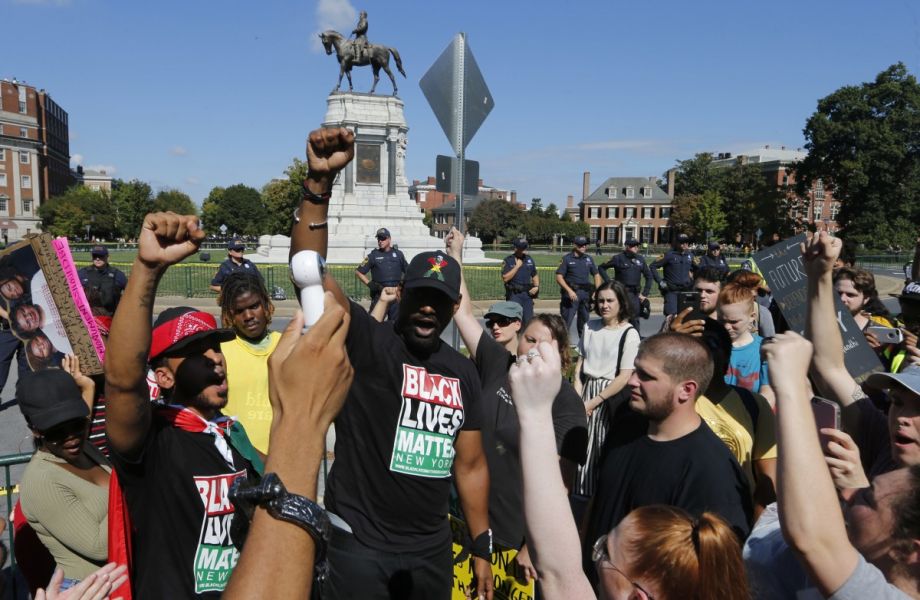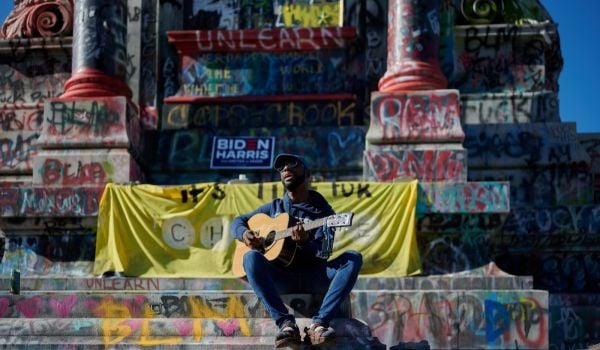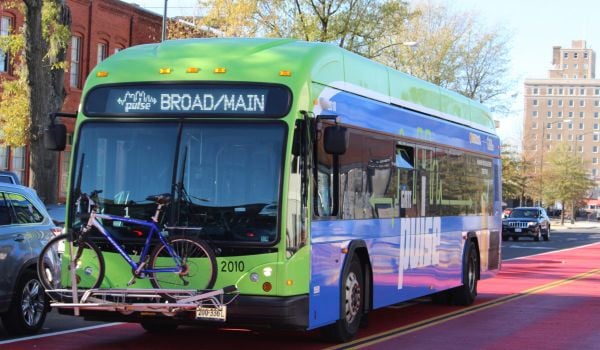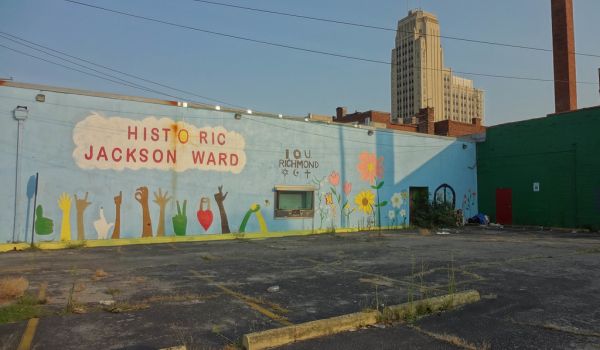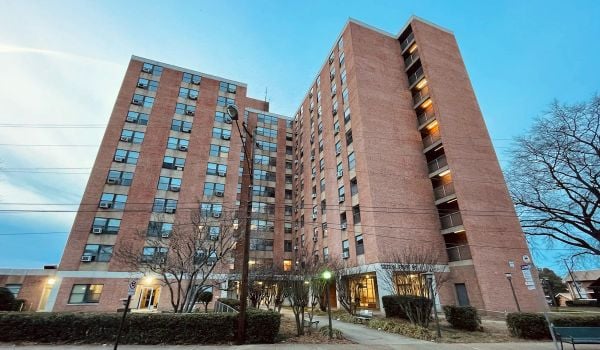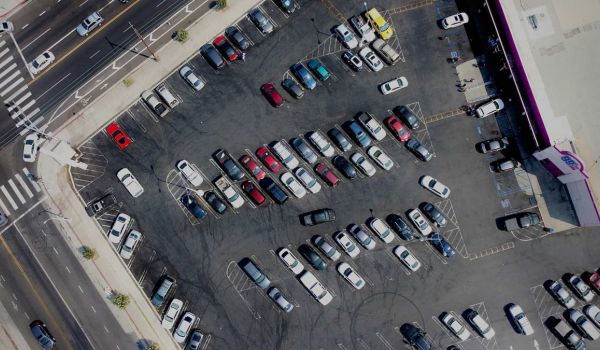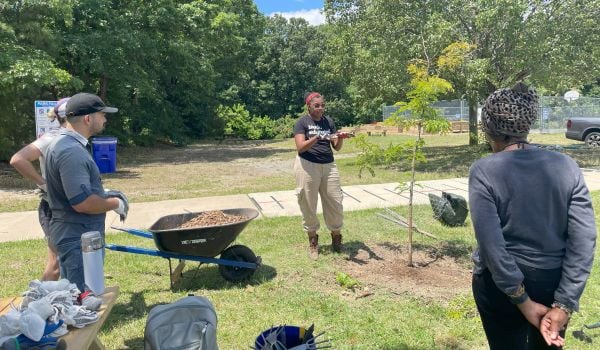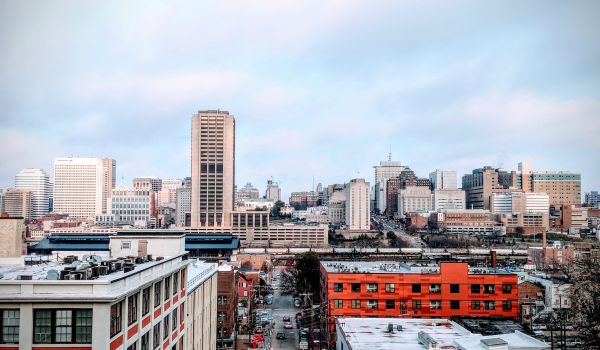EDITOR’S NOTE: This story originally ran in February 2019, more than a year before the sustained nationwide uprisings sparked by the on-camera killing of George Floyd by a Minneapolis police officer. Along Richmond’s Monument Avenue, the statue of Jefferson Davis has been torn down, and as of mid-June 2020, a legal fight is under way regarding the removal of the Robert E. Lee statue. Virginia Governor Ralph Northam, Richmond Mayor Levar Stoney, and the Richmond City Council all have pledged to take the statue down. In the meantime, the now-graffitied Monument Avenue statues have become a gathering place for people protesting police brutality and structural racism.
In Aug. 2017, a town hall forum took place to discuss the future of Monument Avenue in Richmond, Virginia. The thoroughfare was conceived during a site search for a memorial to Robert E. Lee after his death in 1870. Today it is a tree-lined mall, dividing east and westbound traffic, lined with the Virginian Confederate veterans Lee, J.E.B Stuart, Jefferson Davis, Thomas “Stonewall” Jackson and Matthew Fontaine Maury. In 1996 Richmond integrated its most famous street, erecting a monument to Richmond native and African-American tennis champion Arthur Ashe.
Decisions to remove Confederate monuments in Charlottesville and New Orleans prompted Richmond to consider its own. But the August meeting — which drew over 500 attendees — ended up a two-hour shouting match that “bordered on chaotic,” according to the Richmond Times-Dispatch. A few days after the meeting, about an hour away, the “Unite the Right” rally erupted in Charlottesville to protest Confederate monument removal.
A group behind a Richmond design collective was paying close attention. mObstudiO is a partnership of three design departments of Virginia Commonwealth University School of the Arts. Storefront for Community Design is a local nonprofit design assistance center. Working together as mOb+Storefront, the two organizations share studio space and often collaborate.
Monument Avenue has long been of interest to mOb+Storefront. This Thursday, Feb. 14, the collaborative will unveil one result of its sustained conversation around the thoroughfare. An exhibit it’s mounting at The Valentine, a local historic center, will display proposals from around the world that re-imagine Monument Avenue, exploring “its role as an historic urban boulevard, its viability as a 5.4 mile interurban connector, its presence in Richmond given the city’s emergence as a diverse and progressive city, its significance in the history of the United States and in the current debate about Confederate statues in public spaces,” as the collaborative puts it.
mOb+Storefront doesn’t simply want to exhibit the proposals — they want to city to start discussing them. “Race is on everybody’s mind, and has been on everybody’s mind for a long time here,” says Camden Whitehead, an architect, cofounder of mObstudiO and the competition director. “And nobody knows how to talk about it.”
mOb+Storefront’s work around Monument Avenue dates back to 2015. Following the shooting at Emanuel AME Church in Charleston and police shooting of Michael Brown in Ferguson, mObstudiO faculty asked a group of Virginia Commonwealth University design students to design a prosthetic for Monument Avenue’s statue of Robert E. Lee that would alter its meaning.
In November of 2015, mOb hosted a show and standing-room-only panel discussion around the student proposals.
“Having all these proposals around us sort of diffused the situation,” says Whitehad. “It enabled us to talk about the proposals, and not about where an individual stood on the issues.”
It was a stark contrast to the heated Town Hall meeting that summer. “It seemed to enhance the discussion, and make it a lot more constructive,” Whitehead adds.
mOb+Storefront applied for and received a National Endowment for the Arts grant to hold an international design competition to further reimagine Monument Avenue. The competition opened to submissions in May 2018 and closed this past December.
The collaborative invited planners, architects, landscape architects, designers, artists and individuals to submit designs; a separate youth competition included workshops to assist students in designing monuments to heroes they think worthy of the next monument for the avenue.
The Valentine will exhibit all the entries, highlighting the 20 proposals that jurors selected as finalists. Youth entries will be displayed at the Branch Museum of Architecture and Design on February 16th. Visitors will have a chance to weigh in on submissions through a People’s Choice Vote.
But the most crucial aspect of the exhibit will be a series of discussions, the group says. They hope the proposals help steer conversations, while prompting visitors to themselves envision a new Monument Avenue. “A unique aspect of design is that it can focus a conversation,” Whitehead explains.
“I’ve looked through these entries and I think there’s such hope for a better and different future,” says Ryan Rinn, executive director of the Storefront for Community Design and project liaison for the competition. “The beauty of a competition like this is that you can see that realized in ways you probably never thought about.”
Sandy Wheeler, a graphic design professor who is also part of mOb, hopes such conversations can serve as a blueprint for more to come. “It becomes a model for other issues that have to deal with race, and can be extended to other contemporary issues we’re dealing with, like gender,” she says.
Richmond Mayor Levar Stoney formed a Monument Avenue Commission in 2017, which released a report last summer recommending the removal of the Jefferson Davis statue as well as the addition of signage to the four others of Confederate leaders.
Though the City of Richmond is aware of the design competition, there is no commitment or mandate to implement ideas from any of the proposals.
For mOb+Storefront, “it’s a speculative effort to put an offering out there and hope something sticks,” Whitehead says. “Primarily for us, it’s about keeping the conversation going.”
This article is part of “For Whom, By Whom,” a series of articles about how creative placemaking can expand opportunities for low-income people living in disinvested communities. This series is generously underwritten by the Kresge Foundation.

Emily Nonko is a social justice and solutions-oriented reporter based in Brooklyn, New York. She covers a range of topics for Next City, including arts and culture, housing, movement building and transit.
Follow Emily .(JavaScript must be enabled to view this email address)

